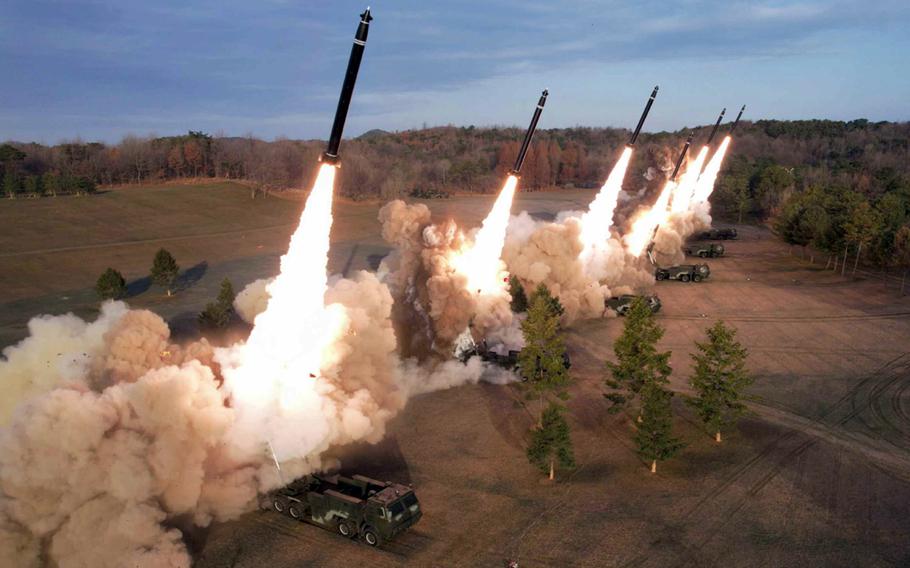As the world debates the authenticity of North Korea’s recent claims of “progress” in the development of a hypersonic missile, an unusually large caliber rocket artillery system it fired earlier this week has baffled experts as to whether it also qualifies as a ballistic missile.
Pyongyang on Monday held exercises that involved firing from the KN-25 Multiple Launch Rocket System (MLRS). A tube rocket artillery whose rockets are 600 mm in caliber makes it the largest such round for the class of weapon.
Some reports also claimed North Korean officials said it can carry tactical nuclear warheads. Its leader, Kim Jong-un, “oversaw” the drill that demonstrated “real war capabilities.”
Following this test, reports emerged claiming North Korea “successfully tested a solid-fuel engine for its new-type intermediate range hypersonic missile.” State outlet KCNA’s reports suggested this was a step towards efforts “to develop a more powerful, agile missile that could be capable of hitting targets further away, including Guam.”
Guam is the leading US military base that will serve as a military and logistical node for operations, particularly against China in the western Pacific. China, too, has missiles like the DF-26 Intermediate-Range Ballistic Missile (IRBM) with a range of 3,500 km, bringing Guam within its reach.
However, displaying two weapons in a span of two days that threaten both Japan and the US indicates Pyongyang views Washington and Tokyo’s strategic rivalry in far east Asia as a threat to itself.
This view has been articulated by Moscow, whose defense minister Sergei Shoigu recently said the US was using the “confrontation” and “rising tensions on the Korean Peninsula and Taiwan” as a “pretext for the expansion of its troop presence in the western Pacific.”

‘Not Artillery Rocket, But Ballistic Missile’?
The KN-25 600-mm rockets, which KCNA said are capable of carrying tactical nuclear warheads, are also slated for increased production. Kim has called for “the need to continuously increase the number of batteries” of the mobile launchers and described its operators as the “main force of the war.”
An official photo showed six heavy-duty military trucks standing in a line and releasing a rocket each from its eastern coast. Both the Japanese and South Korean militaries noted the launches.
Japan’s military reported Monday that North Korea fired three short-range weapons that flew at a maximum altitude of 48 km before falling outside the country’s exclusive economic zone in the Sea of Japan, also known as the East Sea.
South Korea’s Joint Chiefs of Staff reported the same day that multiple short-range ballistic missiles flew more than 297 km before splashing down. Stripes quoted the deputy spokesperson for South Korea’s Joint Chiefs of Staff, Lee Chang-hyun, saying there may be “discrepancies when counting the launches due to the simultaneous firing of munitions.”
However, Lee added that South Korea has “classified” Monday’s “artillery rockets as ballistic missiles due to the projectile’s capabilities and that Pyongyang fired more than the six shown in KCNA’s photos.”
In a statement following the launches Monday, US Indo-Pacific Command also referred to the North’s projectiles as “ballistic missiles.” “The United States condemns these launches and calls on the DPRK to refrain from any further destabilizing acts,” the statement said.
Lee said South Korea, Japan, and the United States are sharing their data on North Korea’s launches, including those fired on Monday. In December last year, Washington, Seoul, and Tokyo activated a “real-time data-sharing system” to trade surveillance and reconnaissance information on North Korea’s missile launches.
The report quoted Yang Uk, an associate research fellow at the Asian Institute for Policy Studies in Seoul, as saying North Korea frequently describes some of its missiles as artillery rounds despite their much larger size.
“In this case, the projectile is described as 60 mm in diameter—you cannot call it artillery. It’s only natural that we call it a short-range ballistic missile,” he said.
Larger Than Other Artillery Rockets
The KN-25 certainly is larger than other operational MLRS systems, like China’s PHL-03, which fires 300-mm rockets; the PHL-16/PCL-191, which can release 370-mm BRE6 rounds; Russia’s 9K58 Smerch (300-mm); BM-27 Uragan (220-mm); and Tornado-S (122-mm and 300-mm).
The US’s MGM-140 Army Tactical Missile System (ATACMS) is fired from the M142 HIMARS launcher and has a caliber of 600 mm it is also called a “tactical ballistic missile” in official literature.
Interestingly, North Korea has been prohibited from conducting ballistic missile tests by the United Nations Security Council (UNSC) resolutions since 2006, which might explain the tweak to repurpose artillery rounds for the purpose.
The launch also comes four days after US and South Korean troops concluded their 11-day Freedom Shield exercise throughout South Korea.
Around 48 joint drills were conducted in the semiannual exercise on air, land, sea and cyberspace. KCNA typically characterizes US and South Korean exercises as rehearsals for invasions of the North.
- The author can be reached at satamp@gmail.com
- Follow EurAsian Times on Google News